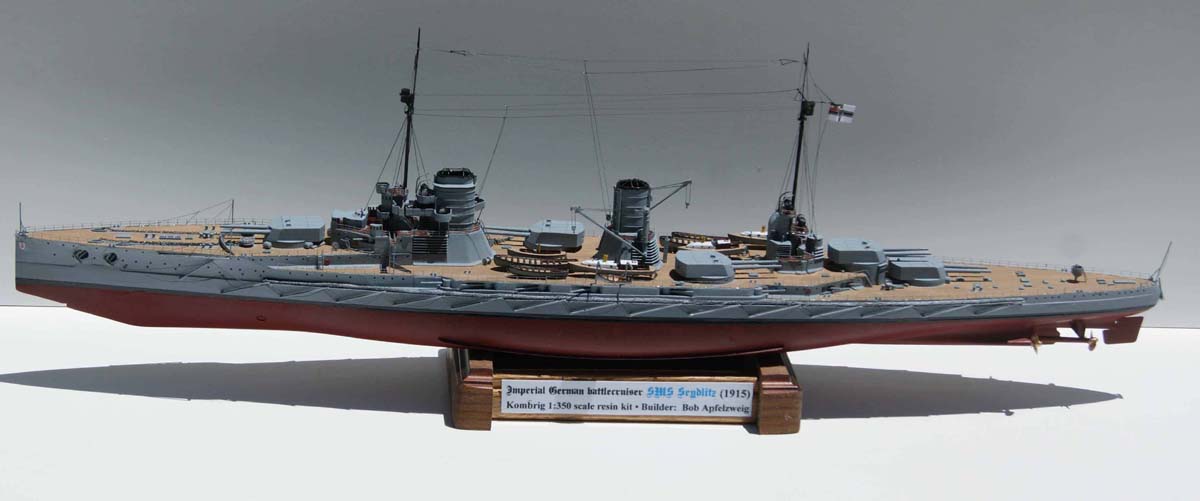
1/350 SMS Seydlitz (Combrig)
|
by Robert Apfelzweig |

1/350 SMS Seydlitz (Combrig)
The Imperial German battlecruiser SMS Seydlitz was commissioned in 1913, and Combrig's resin kit emphasizes its long, lean, no-nonsense appearance. Typical of pre-WWI German dreadnoughts, its uncluttered decks and simple superstructure display an elegance rare for this time period. It was the last WWI German capital ship to mount the (increasingly undergunned) 11-in. (280 mm) main battery, and fought well at the Battle of Dogger Bank (January 1915), when it was severely damaged and nearly destroyed by heavy shell hits from British battlecruisers that knocked out its rear turrets and nearly led to a catastrophic ammunition magazine explosion. Lessons learned from this damage led to German dreadnoughts' barbettes being redesigned to prevent flash damage in the turret from extending into the ammunition handling rooms below, a fact unknown to the Royal Navy, which paid for this lack of knowledge in the loss of three battlecruisers at the great Battle of Jutland in May-June 1916. At this meeting of nearly the entire British Grand Fleet and German High Seas Fleet, the German battlecruisers fought against generally superior British naval forces, first against the British battlecruisers and then against the battleships of the Grand Fleet. The Seydlitz suffered 21 heavy shell hits as well as a torpedo hit in the forward port side; it managed to dodge the pursuing British fleet during the night of May 31 - June 1 and ultimately reached safety at Wilhelmshaven with its bow nearly awash and with over 5 tons of seawater inside its hull. The Seydlitz was repaired by October 1916 but never saw significant action again, being surrendered along with most of the rest of the High Seas Fleet to the Allied navies at Scapa Flow, Scotland, where on the morning of June 21, 1919 it slipped beneath the waves as the German crews, with the British fleet busy elsewhere, scuttled their interned ships to avoid them being seized by the Allies.
Combrig's kit is typical of their recent releases, with generally excellent
detail in the casting of upper and lower hull sections (which fit together
very well), turrets, gun barrels (every one has the muzzle hollowed out),
small boats and superstructure parts. The hollow nature of the hull
sections made it easy to engineer the gun turrets so that they can rotate
while remaining fixed to the hull. The modeler will need to add his own
masts and yardarms. The rather limited photoetch frets include anti-torpedo
net shelves that fit fairly well along the hull, although you will need
reference photos to position them correctly, along with your own net booms
(I was fortunate in having a sufficient number of plastic ones left over
from a build of the Russian battleship Sevastopol, whose own booms were
replaced with brass ones). The anti-torpedo nets were made from shoelaces
with circular cross-sections and mesh exteriors, painted and wrapped in
gray thread. No railings are provided; photos show that the Seydlitz had
two-bar railing and I had plenty of this left over from other builds.
Most of the ladders in the frets were poor quality and so I used Lionroar
ladders (with folding rungs) in most cases. Combrig's assembly instructions
are the usual two sides of one page, with precise location of many parts
(including all the small boats and motor launches) not clearly specified.
There are four shielded 3.5-in. AA guns provided, but only two are used,
as there are pairs of two different but similar types, depending on the
timeframe of the build. As commissioned, the Seydlitz had simple
pole masts with small circular lookout platforms on each; by Jutland, these
had small, possibly armored, lookout housings above them )provided in the
kit, though without instructions for placement), which could probably fit
only one or two seamen. After Jutland, the anti-torpedo nets were
removed (having shown themselves to be largely useless and a liability
in the event of significant hull damage) and the turret tops were painted
a dark color, usually with a white circle on one or two of them so that
the ships could be identified from the air. I chose to model the
ship as she appeared before Jutland, and photos on the internet helped
considerably in various minor details. The decks were painted in
Tamiya wood tan, the hull and superstructure in ModelMaster light ghost
gray, and the lower hull in Liquitex spray-on cadmium red hue 2.
The linoleum decks were Tamiya hull red. I used some spare steel
anchor chain; Combrig's kit includes only undersized 2 dimensional chain
on its photoetch fret, and provides no painting scheme or flags.
